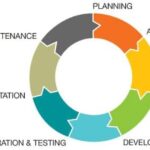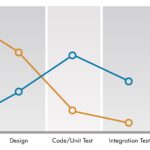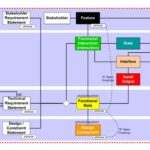Acronyms can be challenging when entering a new engineering discipline, and model-based systems engineering (MBSE) is no exception. In the case of MBSE, numerous acronyms can look very similar, adding to the challenge. It turns out that many of the confusing acronyms are related to software development, not system engineering. That’s because MBSE began as an adaptation of model-based design (MBD) that’s been used to develop complex software systems for many years. This FAQ will present a basic, but far from exhaustive, review of some MBSE- and MBD-related acronyms.
AADL – Architecture Analysis and Design Language. AADL is an SAE international standard designed to model mission- and safety-critical aspects of avionics, cyber-physical, and autonomous systems using a DSML. In MBSE, AADL can be used in combination with SysML.
ADLC – Application Development Life Cycle, more commonly referred to as SDLC, see below.
DSML – Domain Specific Modeling Language. DSMLs are designed to support higher-level abstractions than general-purpose modeling languages in a specific application or system domains, such as automobiles or smartphones.
FIL – FPGA-in-the-loop, see PIL.
HIL, HiL, HWIL, or HITL – Hardware in the Loop. HIL simulation and testing occurs before connecting the embedded processor to the actual hardware by running a simulated plant model on a real-time system.
INCOSE – International Council on Systems Engineering is an organization and professional society in systems engineering. It’s a leader in MBSE, and Its activities include conferences, publications, local chapters, certifications, and technical working groups.
KerML – Kernel Modeling Language. KerML provides a basic set of modeling capabilities used by SysML v2 and differentiates SysML v2 from SysML v1 and UML by adding standard textual modeling notations in addition to graphical views of models. SysML v1 and UML are limited to graphical modeling.
MARTE – Modeling and Analysis of Real Time and Embedded systems. The MARTE language from the OMG can be combined with the UML. It’s an extension of UML designed to support model-driven development of real-time and embedded applications.
MBE – Model-Based Engineering. Is sometimes referred to as model-driven engineering (MDE) or model-driven development (MDD), but it’s not necessarily the same. MBE is a software and systems development approach based on visual modeling throughout the SDLC. Some users recognize a difference between MBE and MDE/MDD: In MBE, the models are sufficiently complete and accurate that they can be used to improve SDLC productivity and efficiency, but they are not automated; MDE/MDD ‘drives,’ and at least partially automates the process using simpler models.
MBD – Model-Based Design. MBD combines mathematical and visual techniques for addressing problems associated with designing control, signal processing, and communication systems. Common applications include motion control, industrial equipment, aerospace, and automotive systems.
MBSD – Model-Based System Design. See MBD.
MBSE – Model-Based System Engineering. INCOSE defines MBSE as the formalized application of modeling to support system requirements, design, analysis, verification, and validation activities beginning in the conceptual design phase and continuing throughout development and later life cycle phases. MBSE is a technical approach to systems engineering that focuses on creating and exploiting domain models, digital twins, and digital threads as the primary means of information exchange rather than document-based information exchanges. Several vendors offer MBSE tools, and each has a slightly different way of presenting the same MBSE processes (Figure 1).

MDA – Model Driven Architecture. MDA is an approach to software design, development, and implementation from the OMG. It provides guidelines for structuring software specifications expressed as models and separates business and application logic from underlying platform technology.
MDD – Model Driven Development. See MBE.
MDE – Model Driven Engineering. See MBE.
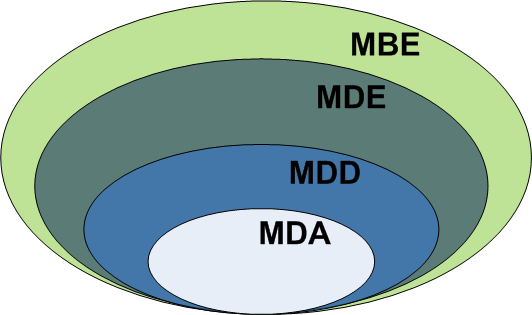
MIL or MiL – Model in the Loop. MIL testing and simulation is the first point for software verification and validation. It verifies that the controller logic produces the required functionality.
MLM – Model Lifecycle Management. In MBSE, MLM involves synchronizing the modeling information over time to ensure a consistent representation of the modeled system. It’s a string in the digital thread.
MLMS – Model Lifecycle Management System. A MLMS is a set of elements that implement an MLM process and may include people, hardware, software, data, and procedures.
MOF – Meta Object Facility. Published by the OMG provides the basis for metamodel definition in the OMG family of MDA languages and is based on simplifying the UML v2 class modeling scheme.
NFR – Non-Functional Requirement. A requirement that delineates criteria for judging the operation of a system, in contrast with a functional requirement that defines a specific function or behavior.
OMG – Object Management Group. A computer industry standards consortium supporting MBSE, SysML, UML, and other related languages and standards.
OOSEM – Object Oriented Systems Engineering Methodology. According to INCOSE, OOSEM is a MBSE method that combines object-oriented concepts with traditional systems engineering practices. Unlike other industry-provided MBSE methodologies and toolsets, OOSEM is not a formal offering from any specific vendor. OOSEM support services are available through the INCOSE OOSEM Working Group.
PIL of PiL – Processor in the Loop. In PIL, sometimes called FPGA in the loop (FIL), the embedded software, algorithms, control loops, and other system elements are run as a closed-loop simulation on the actual processor (or FPGA) hardware instead of on a personal computer or other platform.
PLM – Product Lifecycle Management. PLM provides a database for all information related to a product and provides a communication framework between product marketing, engineering, manufacturing, and field service.
SDLC – System Development Life Cycle or Software Development Life Cycle. The SDLC (also called the Application Development Life Cycle, ADLC) is a six-stage process for planning, creating, testing, and deploying an information system, including requirement analysis, design, development and testing, implementation, documentation, and evaluation.
SGML – Standard Generalized Markup Language. Is a metalanguage and an international standard (ISO 8879) for the definition of markup languages.
SIL or SiL – Software in the Loop. SIL generates code from the controller model and uses that code in place of the controller block.
SMOF – Semantic Meta Object Facility. An OMG standard for MDE.
SoaML – Service Oriented Architecture Modeling Language. SoaML provides a metamodel and a UML profile for the specification and design of services within a service-oriented architecture. It’s from the OMG.
SPDM – Simulation Process and Data Management – SPDM is used to build and maintain the digital thread of the data used and the decisions taken to predict the lifetime and performance of systems and products built using MBSE.
SysML v1 – System Modeling Language, version 1 based on UML.
SysML v2 – System Modeling Language, version 2, independent of UML. It replaces the UML kernel with its kernel modeling language (KML).
UML – Universal Modeling Language. Defines a graphical language for visualizing, specifying, constructing, and documenting the artifacts of distributed object systems. Primarily designed for large software development projects, it was also the basis for SysML v1 and the beginnings of MBSE.
UPDM – Unified Profile for DoDAF and MODAF is an OMG standard. It’s a visual modeling standard initially launched to support the development of architectures in compliance with the USA Department of Defense Architecture Framework (DoDAF) and the UK Ministry of Defence Architecture Framework (MODAF). It has two levels: UPDM L0 incorporates parts of UML 2.0 and SoaML; UPDM L1 has greater functionality with larger overlaps with UML 2.0 and SoaML, plus SysML (Figure 3).
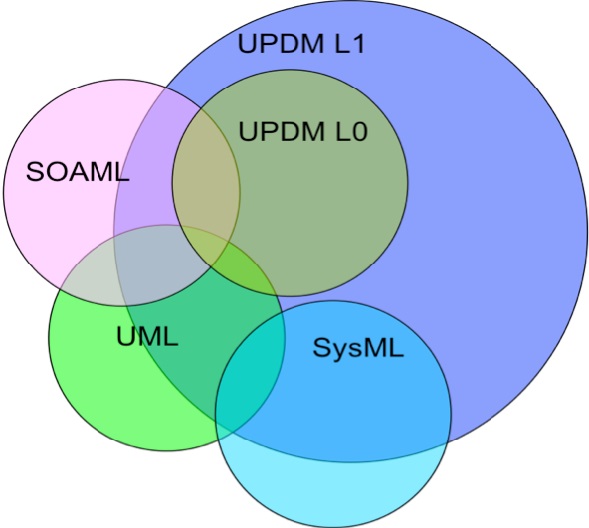
XMI – XML Metadata Interchange. Is an OMG standard that supports the Meta MOF Core defined in ISO/IEC 19508. It covers a wide range of domains and is based on a constrained subset of UML. XMI is a widely used XML interchange format.
XML – eXtensible Markup Language. XML is a simple, flexible text format derived from SGML. Originally designed to meet the challenges of large-scale electronic publishing, XML is also playing a growing role in exchanging a wide variety of data on the Web, with MBSE, and elsewhere.
References
Clarifying concepts: MBE vs MDE vs MDD vs MDA, Modeling Languages
International Council on Systems Engineering
ISO/IEC 19508:2014
Object Management Group
SysML Forum
Using SysML in UPDM Projects, NAVAIR MBSE community
What is Model-Based Systems Engineering (MBSE)?, Fraunhofer IPK


